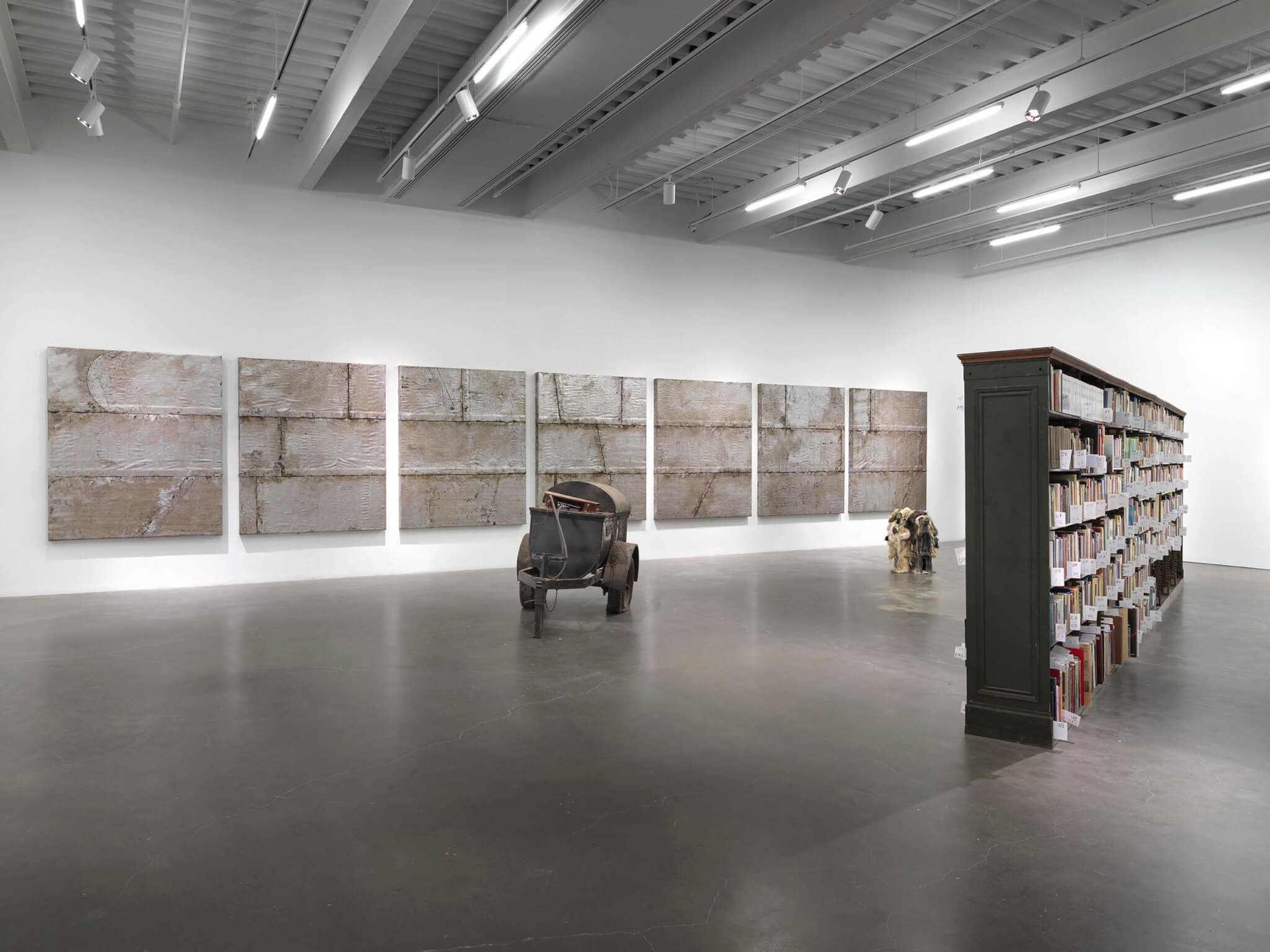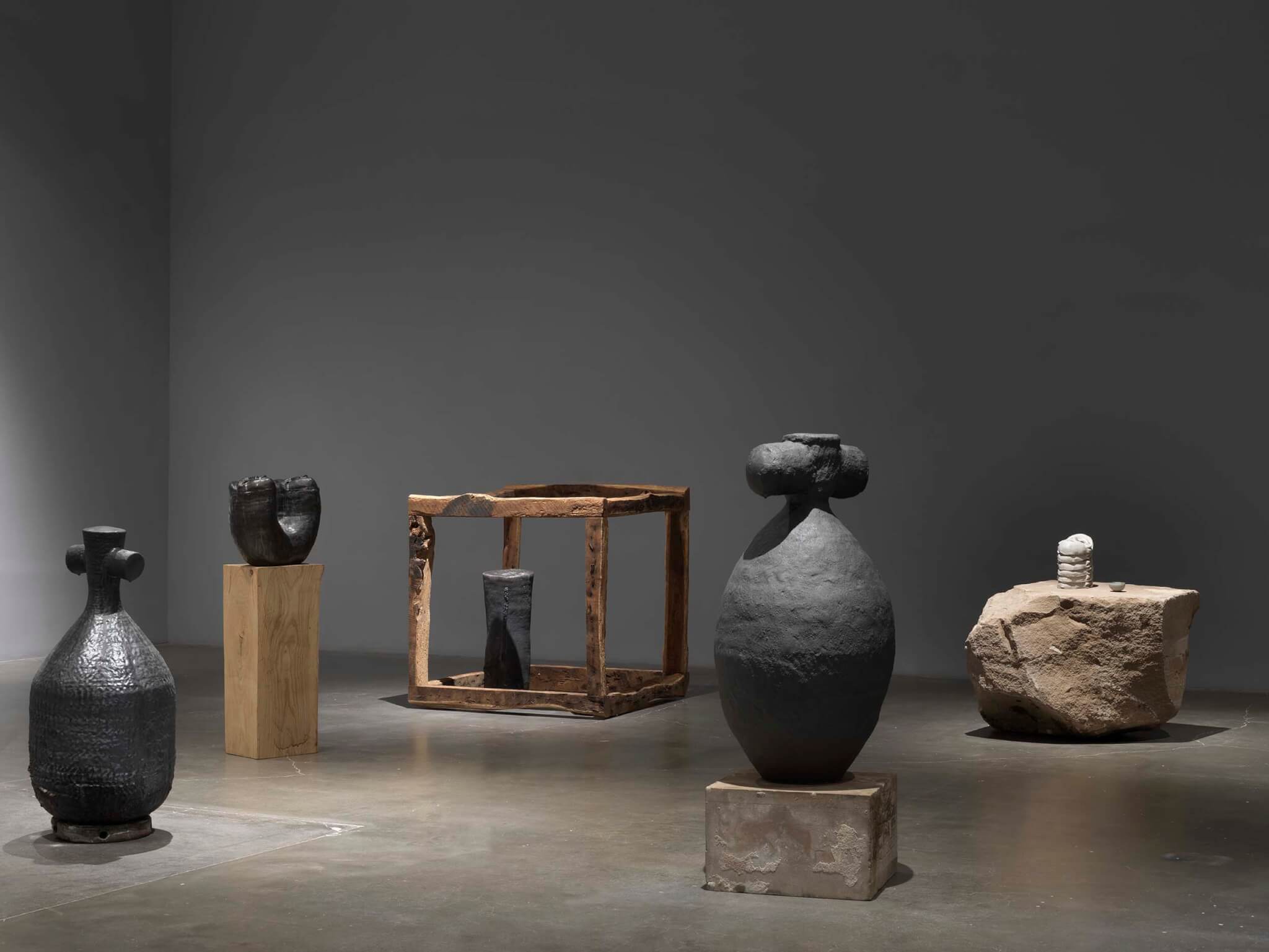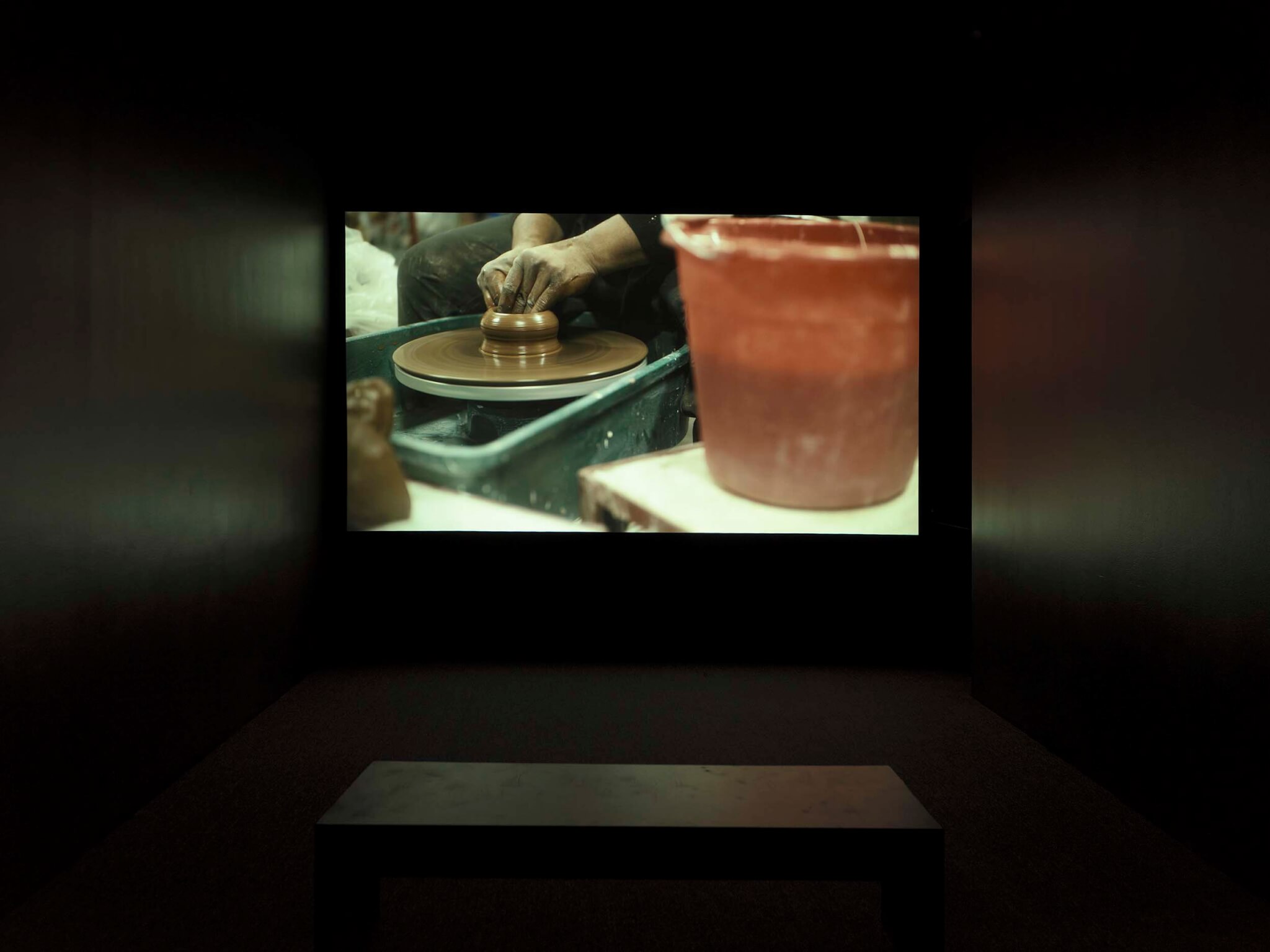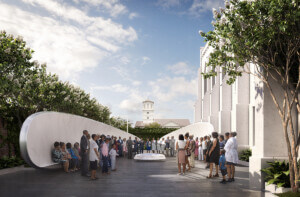Theaster Gates: Young Lords and Their Traces
New Museum
235 Bowery
New York, NY 10002
Open through February 5
In “When the Battle Is Over,” the introductory essay in the catalogue accompanying Young Lords and Their Traces, Theaster Gates explains that the genesis for the exhibition was the loss of two dear friends: curator, writer, and critic Okwui Enwezor and feminist theorist bell hooks. Gates states that with this exhibition, the New Museum temporarily becomes a site of mourning and communing but also mischief and conjuring. The show recognizes the recent loss of a roster of Black Young Lords, including polymath designer Virgil Abloh, theorist Greg Tate, painter Sam Gilliam, and ceramicist Marva Lee Pitchford-Jolly, in addition to Gates’s father, Theaster Gates Sr. It also marks the absence of other influences on Gates’s practice, such as film theorist Robert Bird, painter Agnes Martin, and artist Joseph Beuys.
The power of Young Lords is Gates’s transmutation of both loss and the museum itself. Within the New Museum, he transforms loss into an acknowledgment and celebration of Black creative production and centers the construction of Black subjectivity in the often-abject mundanity of everyday life. These are conditions and works usually not considered to be art or architecture in the highfalutin situations of the art world and the academy. In the lexicon of the Black church, the exhibition can be considered more of a “home-going” service for these Young Lords and a celebration of the liberatory power of Black artistic creativity and labor. As video artist Arthur Jafa (whose elegiac poem “Virgil” is included in this exhibition) stated in a 2018 interview in Artnet News, “Black people figured out how to make culture in free-fall.”
Gates transgressively transmutes the conditions of white-(cube)-space galleries and remixes the secular and the sacred. The Black sermonic model of “three points and a poem”—whereby the preacher conducts an exegetical review of a biblical text, makes three progressively intense points or lessons from that text, and then culminates in a poetic celebration—is a useful precedent. Gates uses it as a curatorial structure across the three floors of the exhibition, beginning with the theme of “archives” on the second floor, continuing with “vessels” on the third floor, and concluding with “communion” in the airy atmosphere of the fourth floor.
When Black churches were outlawed in the 1830s following the planning of slave insurrections, Black people went underground to carve out space in what were called “bush arbors” or “bush harbors” (which also denoted a place of security or refuge). These were simple one-room structures that were never considered “architecture” and were often constructed in the forest out of brush or bushes tied together with rope or vines in the form of an arbor. Yet, within these spaces, Negro preachers creatively appropriated biblical stories and the theology of their slave masters to preach liberation. In the 20th century, the role of the Black church as a space of liberation later translated into the liberative promises of social and political justice of the Civil Rights Movement and in particular Black liberation theology, which posits that liberation is the fundamental goal of theology. As defined by James H. Cone, Black theology is one of liberation that springs from an identification with the oppression of Blacks in America and seeks to interpret religious teachings and biblical history in light of this condition while recognizing the relationships between the Black struggle for justice and theological discourse. Cone’s discourse spans from the spatial praxes of Black power, which itself extends from slave insurrectionists worshiping in bush arbors, to the defiant declaration, “I am Black because God is Black!” This epistemology runs counter to that of Euro-American knowledge systems. It is from this background that Gates questions systems of knowledge, epistemologies, and the archive.

Upon arrival on the second floor, the wall immediately becomes a roof with the monumental Roof Strategies for a Museum Corridor (2022), a 50-foot-long expanse of acrylic paint on rubber torch down roofing, canvas, ink, and plastic. This work is echoed by Seven Songs for Black Chapel #1–7 (2022) on the opposite wall in the main gallery, a series of abstract paintings of industrial, oil-based enamel; rubber torch down; bitumen; wood; and copper commissioned for the 2022 Serpentine Pavilion in London designed by Gates with the support of Adjaye Associates. Sweet Chariot from the series Painting Black with Kettle (2012), a tar kettle gifted to Gates by his father, Theaster Gates Sr., upon his retirement as a roofer in Chicago, is staged in the foreground. The material transformation of tar and rubber torch down in these works destabilizes the histories of European and American modernist abstract painting (like the Russian Suprematist works of Kazimir Malevich and the color field paintings of Mark Rothko) and calls into question their myths, mysteries, and spiritualist overtones. Gates suggests that Black labor and physical embodiment is a different knowledge system for artistic creativity, cultural production, and even spiritual energy. In turn, this suggestion about ways of knowing is answered by various archives in the same room and in the royal red-colored adjacent gallery, including Robert Bird’s archive of 4,500 volumes primarily focusing on Russian literature, film, and modernism; the photographic archives of Ebony and Jet magazines from the Johnson Publishing Company; and A Negro Digest for a Weary Heart (2019), Gates’s work of over 100 bound titles alluding to Black spirituality and the struggle for freedom.


The adjacent gallery also includes an installation of objects and ephemera from collections Gates is preserving, including works made by various Young Lords whose impact is felt in Gates’s practice. These works are presented in hundred-year-old wooden vitrines from the University of Chicago’s Oriental Institute, a research center and museum for the study of ancient civilizations. With this bit of mischief, Gates has substituted his own personal collections for other canons that for centuries excluded African cultures and Indigenous civilizations. While viewing these vitrines, one hears the voices of Black intellectuals (like bell hooks) that accompany the nearby six-channel video installation Art Histories (2019). The piece mixes hundreds of art history slides from the University of Chicago’s Glass Lantern Slide Collection acquired by Gates with photographs from the Johnson Publishing Company. Gates described the resulting interpretive process as “reading Blackness” into the collection. However, through juxtaposing works by Brancusi, Picasso, Giacometti, and Matisse with images of Black life, fashion, bodies, faces, and objects from Ebony and Jet, Gates in fact exposes the unspoken Blackness in the work of these artists.

A stone jar connects exhibitions between the second and third floors and reveals Gates’s sermonic model. The work was made by David Drake, an enslaved African also known as “Dave the Potter” who worked in Edgefield, South Carolina, a center of stoneware production before the Civil War. It resonates with the nearly 40 reliquary stoneware vessels that occupy the main gallery, a “lower chapel” in which one hears Gates intone, “In the beginning was clay; clay was without form!”—a declaration from A Clay Sermon (2021), a 16-minute film presented in a flanking gallery/side chapel. In the film, Gates uses the Black church vernacular of preaching and hymns to conduct an expository sermon on the significance of clay and its material and spiritual transmutations. For Gates, working with clay is a spiritual process that relates the potter to the hand of God while forming “man” from the clay of the earth. The film also folds in the history of Indigenous clay- and brick-making practices, which were in place before those in Europe. The opposite flanking gallery is a choir room where one hears Billy Sings Amazing Grace (2013), Gates’s film that captures soul singer Billy Forston rehearsing a version of the hymn “Amazing Grace” alongside the experimental music ensemble The Black Monks, who are Gates’s frequent collaborators. In Forston’s rendition, original lines of the hymn are switched out for secular references to Black life, much like the sonic elisions that occur between Black gospel music and the blues. In the aediculae of the narrow stairway connecting the third and fourth floors, Gates locates the wood-fired brick-and–clay–oxide sculpture Lady on a Senufo Stool (2021) and Black Jesus (n.d.), painted in oil in a vernacular style common to many Black pulpits.


In the fourth floor’s “upper chapel,” Gates takes us to church. Here he concludes his transmutation of the white cube and of other art spaces like New York’s Park Avenue Armory, where Gates acquired the 138-year-old wood flooring of the Wade Thompson Drill Hall and used it to produce the Floor Works series exhibited here. Beginning with Double Door (2022), he assembles geometric forms in Georgia pine that reference religious symbols and Frank Stella’s striped Black Series. In one corner, a wood-framed shed houses St. Laurence Bell (2014–22), which Gates salvaged from the now-demolished St. Laurence Catholic Church on Chicago’s South Side. Once a sanctuary for Polish and Irish immigrants, the church later became meaningful for the neighborhood’s Black and Latinx communities. Bathroom Believer (2018) occupies the opposite corner; the two-piece installation of 25 porcelain floor panels and 17 rows of industrial fluorescent light strips recalls Gates’s mother, who would retreat to a locked bathroom to pray. The piece simultaneously reads like an altar and references the work of Dan Flavin. These corner installations majestically frame the central A Heavenly Chord (2022), which comprises a Hammond B3 organ, an essential instrument in the Black gospel church, and seven Leslie speakers mounted high on the wall. (They reference Seven Songs for Black Chapel #1–7 [2022] in the second-floor gallery.) The scene is not a quiet artifact or a funereal curiosity: It is activated on select Saturday and Sunday afternoons between 1:00 p.m. and 4:00 p.m. during the run of the exhibition.

This final gallery contains Gates’s most direct references to architecture and the power of the Black radical tradition to elevate the mundane conditions of the everyday into art and architecture. It concludes Gates’s sermonic model and reveals that this power is not predicated upon European epistemologies, techniques, and histories but rather comes from Black ingenuity, making, and believing. At the press preview, Gates described the fourth floor as “a kind of Doric temple,” an “honorific space where the gods are present.”
Returning to the essay “When the Battle Is Over,” Gates notes in that text that from time to time he and Arthur Jafa get on the phone. Hence, it’s useful to lift Jafa’s May 2020 statement and offer it to anyone who sees Young Lords and Their Traces: I’m not a believer, but “I believe in Black people believing.”
Mario Gooden is director of Mario Gooden Studio: Architecture + Design and director of the master of architecture program at Columbia GSAPP.











